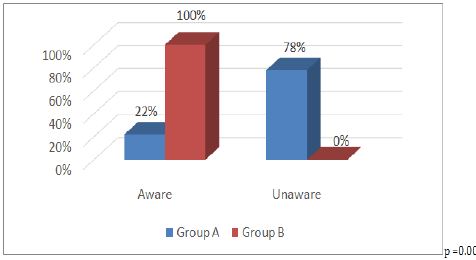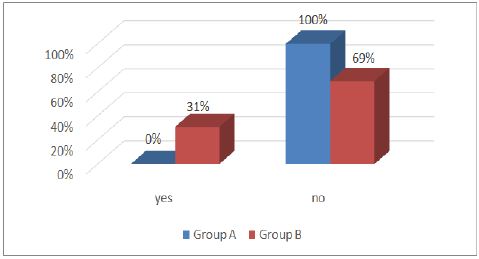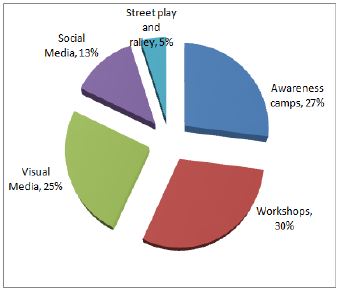Impact Factor : 0.548
- NLM ID: 101723284
- OCoLC: 999826537
- LCCN: 2017202541
*Anna Vinu Varghese
Received: May 21, 2017 Published: May 31, 2017
Corresponding author: Anna vinu varghese, Research Scholar, P.G and Research department of Rehabilitation Science, Holy Cross College, Trichy, Tamil Nadu, India
DOI: 10.26717/BJSTR.2017.01.000116
Introduction: Rubella virus when contracted by pregnant women, causes serious complications including rubella syndrome (CRS). Sensorineural hearing loss is one of the most common complication associated with CRS. In developing countries like India, the awareness towards rubella vaccine is minimal.
Aim: The aim of the study is to evaluate the awareness and attitudes of young females towards rubella vaccination. The study was carried out in female subjects from a medical college (n=100) and an arts college (n=100). Based on the previous literature, a questionnaire was developed and was distributed to the subjects after validity testing. There is a significance difference in the awareness level of rubella vaccine between the two groups. Majority of the non-medical students are unaware of the existence of rubella disease.
Conclusion: The study reveals the lack of awareness programs about rubella disease in Tamilnadu.
Keywords: Rubella Vaccine; Hearing loss; Awareness and attitudus
Rubella is a contagious, generally mild viral infection that occurs most often in children and young adults. The synonyms of Rubella are German Measles, 3 day measles etc. The pathogenic agent is Rubella virus of the genus of Rubivirus and belongs to the family of Togaviridae. The transmission of the virus is by airborne droplets when infected people sneeze or cough. Humans are the only known host. The symptoms include appearance of a rash all over the body, fever, swollen glands, joint pain, headache, conjunctivitis etc. Rubella infection in pregnant women may cause serious complications including fetal death or congenital defects known as Congenital Rubella Syndrome. When a woman is infected with the rubella virus early in pregnancy, she has a 90% chance of passing the virus on to her fetus. Worldwide, an estimated 110 000 babies are born with CRS every year (WHO, 2007) [1- 4]. Some of the complications of CRS include miscarriage/still born baby, neonatal thrombocytopenia, low birth weight, severe heart disorders, autism, thyroid dysfunction, diabetes mellitus, hepatitis, anemia, eye defects and hearing impairment. No specific treatment is available, but preventable with vaccination. Largescale rubella vaccination during the past decade has practically eliminated rubella and CRS in many developed and in some developing countries. The WHO Region of the Americas has had no endemic (naturally-transmitted) cases of rubella infection since 2009. (WHO, 2012) [5]. Sero-epidemiological studies in India have shown susceptibility of 20-46 per cent in women of child bearing age, hence it is necessary to prevent the infection among women of child bearing age. (WHO, 2012). The best way to prevent rubella and CRS is vaccination, which has been applied all over the world. About a third of the world’s countries still lack rubella vaccination programs including India.
To study the awareness and attitudes towards Rubella vaccine among the Medical students and Non-Medical students in Trichy.
The present study was designed as a comparative cross sectional study conducted among the medical students and nonmedical students in two reputed colleges in Trichy [6-8].
Approval from the Independent Ethical Committee of Holy Cross college, Trichy was obtained before conducting the study. The study did not involve any interventional or invasive procedures. Informed consent was obtained from all the participants and they were informed about their right to opt out of the study any time and assured their confidentiality.
The participants were identified through the official rolls and enlisted for inclusion of the study.
Inclusionary criteria
Table 1: Demographic data of the participants.

The study proceeded in four phases.
Questionnaire construction: Based on previous literature an 18 item questionnaire was conducted. The questionnaire included 15 dichotomous, 2 multichotomous and 1 open ended questions.
Validity Check and Pilot study: The validity check was carried out by 3 Speech Language Pathologists and1 Physician. After making the recommended changes, pilot study was carried out in 10 medical and 10 non-medical students. The pilot study yielded expected results.
Data Collection: The data collection was conducted through survey method. The questionnaire was distributed to the participants and collected back after completion. The completion of the questionnaire lasted for approximately for 10-15 minutes.
Data analysis: Data analysis was carried out using SPSS 16 software. Independent samples test was used wherever necessary. A p-value <0.05 was considered statistically significant.

Figure 1: The general awareness about Rubella virus, its causes and vaccination.

Figure 2: The awareness about the availability of Rubella vaccine.

Figure 3: The association of Rubella virus and Hearing loss.

Figure 4: Suggestions to create awareness about Rubella.
Table 2: Sources of Information about Rubella vaccine.

All the medical students were well aware of Rubella disease, its causes and its vaccination where only 22% of the non-medical students were aware of the same (Figure 4). None of the non-medical students were aware about the availability of the vaccine in their area where 31% of the medical students were aware of the same. 99% of the non-medical students are unaware about the fact that Rubella can cause hearing loss where 47% of the medical students were aware of the same. 79% of the medical students opinioned that they are well aware of Rubella virus and its vaccination because it is included in their syllabus. When asked about the different ways in which we can create awareness about Rubella virus, its causes, complications and vaccination, the students suggested workshops, seminars, visual media, social media, street plays etc.


